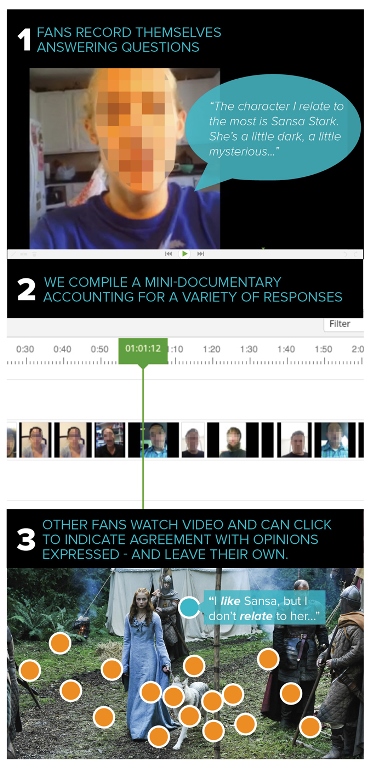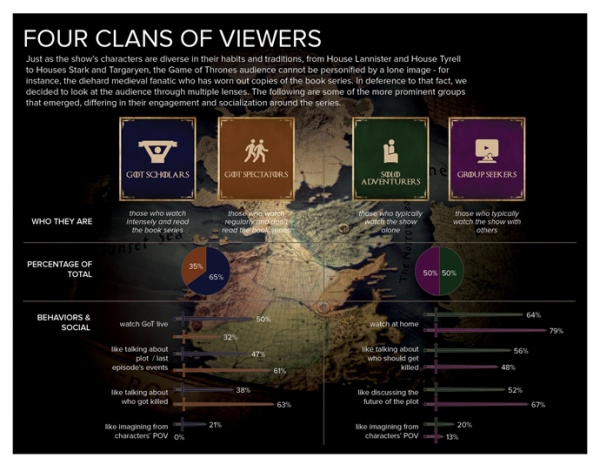Editor's note: Kadley Gosselin is content and communications manager at Latitude Research, Beverly, Mass. Ian Schulte is CEO of Latitude Labs, Portland, Ore.
In an increasingly connected, visual world, one-third of all online activity is spent watching video. In an effort to create more engaging experiences for our participants, reach new and better insights and create richer outputs, we have been experimenting with new methods that use video as an input in an online social setting, mimicking the activities people are already engaging in every day. In our latest study, My Game of Thrones: an Audience Self-Portrait, we used video-based ethnography to explore fandom around the smash HBO show. With a massive mob of nearly 20 million people who are engaging in everything from cosplay, fan fiction, intense online commentary, creating spinoff merchandise and more, we thought the Thrones audience should be studied as a model for fandom.
Going into the project, we had the following objectives:
Explore new forms of ethnography. In all of our work, we study the audience, but more often than not, we are the ones in control, guiding people through a survey, interview or online activity. We wanted participants to run the show – as video creators and as respondents – sharing their own experiences, on their own terms, through a medium that’s inherently engaging and familiar, and in a manner that felt more conversational than traditional research.
Determine what unites and excites the fans. Widespread popularity and mobility around shows like The Voice and Big Brother is easy to grasp; the shows adhere to tested and successful formulas, typically void of polarizing subjects like violence, social stigmas and gender roles. Game of Thrones is both ripe with controversial themes and a member of the bastard child of TV genres: sci-fi/medieval/fantasy. Yet despite flying in the face of expectations for blockbuster TV shows Game of Thrones has become HBO’s most viewed show ever. The GOT audience is fandom personified. What are the common threads that align 20 million viewers and keep them coming back for more?
Go deeper than a traditional qualitative ethnography. What makes Game of Thrones unique? What narrative elements make it so successful? What lessons can other networks learn from the show to provide equally engaging media experiences? Our goal was to look at fans’ psychological reactions while they watch. We hoped that by connecting fans of the show in a social activity we would be able to answer the above questions and take the traditional qualitative ethnography several steps beyond normal.

Uninhibited responses
Our video-based approach to ethnography is called Echo. For the first phase of a project, we employ a video questionnaire (Figure 1), asking participants to self-record their answers to questions on their smartphones, providing an honest, personal perspective free of social pressure. Next, we compile their video responses into a mini-documentary. Finally, we show that video to a larger body of participants in our media-testing application, Lumière, and ask them to react to what they see in real-time by answering questions and interacting directly with the video (rating it, commenting on it and so on). Through Echo, participants are able to express themselves in their own words and write their own experiences onto others’, forming a social video dialogue of sorts.
So what did we find out? While Game of Thrones is mainstream, fans don’t see it that way. Despite the show’s widespread popularity, less than a third of people thought that fans “could be anyone, really.” Even casual viewers shared this view, and those who read the book series were even less likely to agree that the show is mainstream. Despite the show’s large viewership, Game of Thrones fans still act, move and socialize like a much more niche audience.
Passionate fans thrive on complexity and ambiguity. We found that while the average viewer is more concerned with simply keeping up with the show’s unpredictable plot, more loyal fans (defined by more intense viewing habits) sink their teeth deep into character ambiguity and complexity. The Tyrion Lannister character has become a focal point within this trend; even if he’s not their “favorite,” he exemplifies the show’s penchant for complex characters that shirk clear boundaries between good and evil.
There are four clans of viewers. Much like the show’s characters, Game of Thrones fans have diverse rituals. In recognition of this fact, we decided to look at the audience through multiple lenses. Figure 2 summarizes some of the more prominent groups that emerged (Scholars, Spectators, Solo Adventurers and Group Seekers), differing in their level of engagement and socialization around the series.

What makes Game of Thrones unique?
Setting is king. The majority (54 percent) of fans said the show’s setting was their top reason for watching. The magical, mysterious world of Game of Thrones provides a rich backdrop that gives added weight and intrigue to what are ultimately very realistic characters. The combination of the epic and the intimate, real and unreal in this world allows the audience to bathe realistic characters in larger-than-life scenarios.
Character depth. The ultimate appeal of the characters is linked to the unpredictability of the storylines – the characters do the truly unexpected in many situations. What’s even more powerful is that they’re capable of real movement and change; nearly half (44 percent) of respondents agreed that this quality was the main reason to pick favorites and in turn this character loyalty only creates deeper audience loyalty over time.
Unpredictability. Unpredictability is almost always a plus in television but is not always truly present; GOT has it in spades. The result: a sense of living with and like the characters in the show’s often harsh world of Westeros, never knowing what’s really around the bend. While fans who read the book series and watch the show “intensely” know some of the story paths, the majority of viewers have become invested in the fears and hopes of the characters in this unpredictable narrative space.
Implications and opportunities
Our findings point up a host of implications and opportunities for all storytellers.
Niches are the new mainstream. Game of Thrones is a prime example that every genre is now ready for primetime and programmers and producers need not be wary of subjects typically reserved for niche followings. With an ever-growing array of networks and viewing options, dedicated smaller audiences can be positively evangelistic in their level of engagement – and even lay the groundwork for potentially bigger hits.
Strive to build a rich, vibrant world. The success of Game of Thrones can be attributed to its numerous storylines and multidimensional characters, all placed within a specific, unique universe. Creating real variety and abundance of people and plotlines in the same series attracts diverse audiences that can latch onto different elements to fuel their fandom.
Encourage conversation (but don’t try to control it). Social interaction is a boon for a TV program. Networks will often, though not always successfully, try and guide the conversation through a few desired channels. Do more to encourage social behavior around a show wherever and however it may exist – in social media and blogs, at real-world events, through artistic pursuits, etc. – because in the end, a diversity of communication channels will enhance adoption and commitment to the show.
Brands can stay in character. As casts of characters become more varied and plots get more complex, every brand should be able to find at least one thread that resonates with its identity without needing to resort to appeasement (see the Google Play Retribution ad). Finding this point of resonance will yield a genuine connection with fans of the show who appreciate that same thread and will help avoid the risks of pandering or compromise.
Best practices
Based on our experience with this and other projects, what are some best practices for using video in social research?
Video can be used as conduit to understanding all sorts of real-world things. Video testing is usually reserved for testing the literal content of a video – narrative progression, character introductions, visual composition, messaging, etc. – but there’s so much more to learn through video. From shopping journeys to trend-spotting, viewing routines, personal values and mind-sets, getting creative about what you capture with video opens up worlds of research possibilities.
Don’t just use video to use video. Before you think about using video to conduct audience research, ask yourself why you are using it. What can it deliver that more traditional methods wouldn’t? Would you want to watch and interact with the video you’re putting in front of respondents? If done well, video-based research can take participant engagement (response frequency and quality) to new heights. It does, however, require you to think a little bit like a producer and gut-check your videos to make sure they’re going to get the job done right.
Be prepared to rethink the researcher/participant relationship. Related to the point above, get comfortable with putting your participants in the driver’s seat (or at least more so than you’re used to). Video-based research can facilitate a freedom of expression that isn’t always typical of more traditional methods but you have to be willing to take a step back. By all means, ask questions if there’s something specific (and structured) you need to know about, but try not to interrupt the viewing experience more than you actually have to. Remember: an engaged participant is a happy participant and a happy participant will take time to respond thoughtfully.
